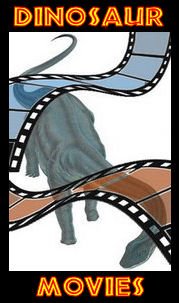 so in the words of the museum's spokesman john acron (i've met him before!) "welcome to the royal tyrrell museum" though of course "this is not the museum it is merely the sign!"
so in the words of the museum's spokesman john acron (i've met him before!) "welcome to the royal tyrrell museum" though of course "this is not the museum it is merely the sign!"
now of course you want to know more about the museum as opposed to the sign so...
the museum to start off with, is located within midland provincal park, and thus technically makes it just "outside" of drumheller. it is halfway along the north dinosaur trail (the trail being two roads that run east/west one on each side of the red deer river valley on which most of the valley's tourist attractions are located). it is either a 5 minute car drive or an hour walk from downtown drumheller.
 the royal tyrrell museum of palaeontology is the only major museum in all of canada dedicated to just the science of palaeontology. the museum's slogan "celebrating life" summarizes this topic perfectly, if you ask me.
the royal tyrrell museum of palaeontology is the only major museum in all of canada dedicated to just the science of palaeontology. the museum's slogan "celebrating life" summarizes this topic perfectly, if you ask me.
the museum opened in 1985 as just the plain old tyrrell museum of palaeontology. however 10 years later in 1995 due to the museum's important work and increasing reputation the queen of england gave it her approval, and it gained the royal on the front of its name.
being run and operated by the government of alberta the tyrrell runs on a philosophy of preserving, protecting, and presenting the fossils of the province for albertans now and forever to enjoy. due to museum's specialization in palaeontology it is headquarters for a lot of the fossil management in the province. if you want to dig in alberta you'll need to apply to the museum for the permit (though if you don't have a PHD you most likely won't get it... trust me i've tried!).
 to help it with its mission of preserving, protecting, and presenting the museum has a whole army of palaeontologists in its employ. just like my buddy dr. françois therrien here.
to help it with its mission of preserving, protecting, and presenting the museum has a whole army of palaeontologists in its employ. just like my buddy dr. françois therrien here.
each one has a different interest and speciality so that the museum can study and present as much of the science as possible without too much overlap. these palaeontologists function as curators, whose job is to direct and supervise the collection, research, and presentation of fossils in their field of study. its an important job (and one i some day hope to get!).
when i left the museum it had 6 curators, but in response to some really sad deaths and just ordinary staff changes the museum now has 7. a few of whom i've never met...
 well in order to preserve, protect, and present anything the tyrrell of course must collect fossils. with its crew of very talented and dedicated technicians, like fossil hunter extraordinaire and all round nice guy darren tanke above, the museum is very good at collecting them.
well in order to preserve, protect, and present anything the tyrrell of course must collect fossils. with its crew of very talented and dedicated technicians, like fossil hunter extraordinaire and all round nice guy darren tanke above, the museum is very good at collecting them.
the tyrrell actively excavates (that's the biz term for digging/collecting) fossils from dozens and dozens of sites all over alberta that yield everything from dinosaurs, to marine reptiles, ice age mammals, fossil pollen, placoderm fish, and various invertebrates. however they have collected many times outside the province as close as BC and as far away as china and even antarctica!
 so how do you preserve and protect fossils. well the number one favour you can do the fossils, so they stick around, is to get them out of the damaging elements. pretty much everything nature does from raining, snowing, being sunny, or windy damages fossils. if they are left outside in the elements these remains of the deep past would erode into nothing more than dust. instead the museum brings them back to the museum (or sometimes one of a couple warehouses it has) and stores them in the unprepared collections.
so how do you preserve and protect fossils. well the number one favour you can do the fossils, so they stick around, is to get them out of the damaging elements. pretty much everything nature does from raining, snowing, being sunny, or windy damages fossils. if they are left outside in the elements these remains of the deep past would erode into nothing more than dust. instead the museum brings them back to the museum (or sometimes one of a couple warehouses it has) and stores them in the unprepared collections.
as john acron funnily puts it "and why are they unprepared you might ask? i mean hey, these fossils have been around for millions of years you think if they were going to be prepared for something, they would be by now!". of course unprepared means that the fossils have only been worked on by people enough to safely get them out of the ground. they typical need more work to be fully seen and studied. the process by which we clean them off is called preparation.
like all good museums the tyrrell has a huge back log of unprepared specimens. the majority these were collected in the 80's, 90's, and 2000's, but a fun game to play in the unprepared collections, as they're all labelled, is finding the oldest jacket! . the oldest i could find was from 1937, and there many others of dates between this and 1985.
 in order to get these fossils prepared the tyrrell has state of the art fossil preparation labs and facilities. here the techicans, like my friends david and dawna here, patiently and carefully work on cleaning off and repairing these fossils so they can be looked at and studied.
in order to get these fossils prepared the tyrrell has state of the art fossil preparation labs and facilities. here the techicans, like my friends david and dawna here, patiently and carefully work on cleaning off and repairing these fossils so they can be looked at and studied.
every specimen is given a number, and is stored in an appropriate section of the collection. all the fossils are catalogued in huge books that include information like where the specimen was found, who found it, who prepared it, and even which scientific literature it is mentioned in.
over 200 000 fossils are catalogued in the collection, of which over 93 000 are dinosaurs. this makes it the largest fossil collection in canada, and one of the larger collections throughout the world. nearly a hundred scientists visit the museum every year to look and and study the fossils in these collections (and it can be way more when the museum is hosting a big gathering of scientists like a conference or synposium!).
 the tyrrell however is much more famous for the last of its three directives, and that is the presenting. the museum boasts world class fossil exhibits open to the public all year round. so world class that many other museums have visited it to get ideas for their own displays. i'll be taking you on a virtual tour of these shortly...
the tyrrell however is much more famous for the last of its three directives, and that is the presenting. the museum boasts world class fossil exhibits open to the public all year round. so world class that many other museums have visited it to get ideas for their own displays. i'll be taking you on a virtual tour of these shortly...
over 300 000 visitors check out the museum each year, and about 200 000 of these come during the summer season. i remember this crazy stretch of 3 months well! rounding off the presentation side of things the museum has cutting edge education and interpretation programs and services. these range from knowledgeable staff (and some dinosaurs ;p ) on the museum floor to answer guests' immediate questions, to tours and hikes, school programs, and even a full on summer camp!
rounding off the presentation side of things the museum has cutting edge education and interpretation programs and services. these range from knowledgeable staff (and some dinosaurs ;p ) on the museum floor to answer guests' immediate questions, to tours and hikes, school programs, and even a full on summer camp!
i used to work in this portion of the museum for the most part when i worked here. being everything from a dinosaur on the gallery floor to a expert guest at the badlands science camp i got around presenting (even with my brain if i got it wrong a lot!).
so that in a nutshell is the museums overall structure and battleplan. now to take you on a quick virtual tour of the museum. some of this stuff is new, and i hadn't seen it till this recent trip. so it just goes to show much like the prehistoric life it it presents within the museum is evolving itself.
 the entrance to the museum galleries is brand new. back in my day it was a giant globe floating in space. now it is a much more impressive recreation of alberta 70 million years ago. here you will encounter a pack of albertosaurs wandering through a dried up riverbed.
the entrance to the museum galleries is brand new. back in my day it was a giant globe floating in space. now it is a much more impressive recreation of alberta 70 million years ago. here you will encounter a pack of albertosaurs wandering through a dried up riverbed.
i'd run into the albertosaurs before when i briefly tried to get my job back in the xmas of 06. whats really cool about this new display, beyond the fact its cool pretending to walk back in time, is that it is self interpreting. meaning there's no signs to tell you what you're looking at or more to the point where and what to look at in the first place. it is just as if you travelled back in time and can explore it on your own.
whats really cool about this new display, beyond the fact its cool pretending to walk back in time, is that it is self interpreting. meaning there's no signs to tell you what you're looking at or more to the point where and what to look at in the first place. it is just as if you travelled back in time and can explore it on your own.
so for example you have to both notice the scars on the snout of this running albertosaur, and figure out possible causes for them on your own.
 right down to minor but amazing details like all these replica fish, turtles, and invertabrates in a small pond.
right down to minor but amazing details like all these replica fish, turtles, and invertabrates in a small pond.
there's all sorts of other things to spot and think about, but i'll leave that till a later post or for you to see yourself when you visit the museum.
Great Minds Fresh Finds

next up is this display, which not only showcases the curators of the museum, but also their current work. its a really nice setup, and if you're not familiar with the scientists of the museum its a great way to get to know what their up to.
 its also the area where any tyrrell fossils recently in the news are put on display. such as this eggnant adocus turtle (that's my new word for pregnant with eggs... i hope it catches on!) which you may have heard about a couple months ago or read about on the blogs.
its also the area where any tyrrell fossils recently in the news are put on display. such as this eggnant adocus turtle (that's my new word for pregnant with eggs... i hope it catches on!) which you may have heard about a couple months ago or read about on the blogs.needless to say the whole great minds fresh finds area has changed a lot since the last time i was here. what with new research in the past 2 years, and some new curators starting on since than.
Lords of the Land
 another sort of new, but yet not really, area is the lords of the land. it used to be called the theropod hall and showcased meat eating dinosaurs from around the world. now they've replaced all the foreign theropods with alberta ones, and redecorated and re lite the exhibit so it looks like an art gallery.
another sort of new, but yet not really, area is the lords of the land. it used to be called the theropod hall and showcased meat eating dinosaurs from around the world. now they've replaced all the foreign theropods with alberta ones, and redecorated and re lite the exhibit so it looks like an art gallery.

it looks really nice and artsy, but at the same time is an extreme case of what i call "museum lighting". it looks real nice when you're there, but you can't really take pictures. worse the lighting directs and dictates what and how you see the specimen. it takes the exploration out of the museum visit and it tells you what to see, and i think that kinda takes the fun out of it.
the show case piece of this hall is still the mounted tyrannosaurus rex in the centre of the display. it is one of two tyrannosaurs the tyrrell boasts... of course the other t-rex is a little more signficant to me. that being my mother the huxley tyrannosaur.
next you hit the "main" galleries of the tyrrell which are fossil halls setup as though you were travelling from the beginning of life towards the present. so the first place you'd end up on such a time journey would be...
The Burgess Shale
 one of the tyrrell's coolest displays has to be its burgess shale recreation. here you travel through a magnified scene of the cambrian as though it were in a fish tank (the animals are 12 times their original size as otherwise you won't see most of them well). it even has a glass floor that allows you to look at the ocean floor your walking above.
one of the tyrrell's coolest displays has to be its burgess shale recreation. here you travel through a magnified scene of the cambrian as though it were in a fish tank (the animals are 12 times their original size as otherwise you won't see most of them well). it even has a glass floor that allows you to look at the ocean floor your walking above.
the only problem with it is that it doesn't photograph well as you can see. so be sure to visit just for this exhibit. there isn't another burgess shale display this cool i've ever heard of! there is also a nice interpretive section on the burgess shale, and the tyrrell's efforts in the 1990's to find other sites around field with the same critters.
there is also a nice interpretive section on the burgess shale, and the tyrrell's efforts in the 1990's to find other sites around field with the same critters.
 it also has a huge selection and display of burgess critters. which was cool to have when i was first reading wonderful life. i could just run up stairs from where i was reading and look at the stuff. not that i want to rub it in. it just made the book that much cooler!
it also has a huge selection and display of burgess critters. which was cool to have when i was first reading wonderful life. i could just run up stairs from where i was reading and look at the stuff. not that i want to rub it in. it just made the book that much cooler!Devonian Reef


the first display you hit coming down stairs is the highlights of life's conquest of the land. its a cool display that shows you the progress from the first tiny plants to make it onto land all the way to amphibans emerging into a fully developed terristial ecosystem.
Permian Hall
 next we come to the biggest extinction in the earth's history. despite alberta not really having much fossil material from this time, using casts from elsewhere in the world the tyrrell shows off this time period well.
next we come to the biggest extinction in the earth's history. despite alberta not really having much fossil material from this time, using casts from elsewhere in the world the tyrrell shows off this time period well.
 among my favourite is the wall of skulls of the bizarre and diverse reptiles and sort of reptiles that are from this era. if you think dinosaurs had the monopoly on weird, one look at this wall should hopefully fix your opinion. mind you in this pic dimetrodon isn't one of the weirdos. all around him are some though. my photos of them didn't turn out so well sadly :(
among my favourite is the wall of skulls of the bizarre and diverse reptiles and sort of reptiles that are from this era. if you think dinosaurs had the monopoly on weird, one look at this wall should hopefully fix your opinion. mind you in this pic dimetrodon isn't one of the weirdos. all around him are some though. my photos of them didn't turn out so well sadly :(
 speaking of dimetrodon what permian display won't be complete without everyone's favourite not a dinosaur. emphasis on the display is made that this is not a dinosaur, but rather the apex predator of another time, and an ancestor to you mammals!
speaking of dimetrodon what permian display won't be complete without everyone's favourite not a dinosaur. emphasis on the display is made that this is not a dinosaur, but rather the apex predator of another time, and an ancestor to you mammals!
Cretaceous Garden
immediately after the permian display, is a tucked away entrance to the most often missed part of the tyrrell, the cretaceous garden. seriously now that you've been warned watch for it! the gallery staff get the question of where the garden is seriously hundreds of times a day.
this is a special living collection of plants whose decsendents were alive in alberta during the cretaceous.
it is a special place to me as for 2 years of my life this was my home! i lived here for most of my time in drumheller, and all of my time after getting my job at the tyrrell (immediately after being hired i was kinda kicked out of dan and craig's apartment and this is where the museum put me up).
Triassic Giant
 my favourite of the new things added since my departure was the triassic giant. ever since the death of marine reptiles curator betsy nicholls in 2004, her greatest work has sat in the museum collections unseen by the public. finally in this tribute display, her magnificant shonisaurus sikanniensis the largest marine reptile known, is out for all to see!
my favourite of the new things added since my departure was the triassic giant. ever since the death of marine reptiles curator betsy nicholls in 2004, her greatest work has sat in the museum collections unseen by the public. finally in this tribute display, her magnificant shonisaurus sikanniensis the largest marine reptile known, is out for all to see! i'll be blogging about this huge ichthyosaur later...
Dinosaur Hall
 of course the main attraction of the museum for most is the dinosaur hall. one of the largest in the world with over 30 dinosaur skeletons on display in one hall, and most of which are mounted in life like positions.
of course the main attraction of the museum for most is the dinosaur hall. one of the largest in the world with over 30 dinosaur skeletons on display in one hall, and most of which are mounted in life like positions. my only complaint is that the hall is ALMOST presented in chronologic order. except there are NO triassic dinosaurs present, and that it goes from the late jurassic straight to the late cretaceous. i know this is mostly due to the museum in its beginning setting up a trade for some jurassic dinosaur casts in exchange for an albertosaur and some duckbills with an american museum. besides these jurassic dinosaurs all the major skeletons are those of albertan dinosaurs.
my only complaint is that the hall is ALMOST presented in chronologic order. except there are NO triassic dinosaurs present, and that it goes from the late jurassic straight to the late cretaceous. i know this is mostly due to the museum in its beginning setting up a trade for some jurassic dinosaur casts in exchange for an albertosaur and some duckbills with an american museum. besides these jurassic dinosaurs all the major skeletons are those of albertan dinosaurs. this is in some way a minor complaint from a real dinosaur stickler... can you blame me. i am one afterall!
this is in some way a minor complaint from a real dinosaur stickler... can you blame me. i am one afterall!
no the dinosaur hall is pretty fantastic. it has a representative of every major clade of dinosaur except prosauropod and hypsilophodontid (though the theropods are pretty coelurosaur centric... partial due to alberta's theropods all being coelurosaurs, and also the pack of the primordial feather pushing for this)
it has a representative of every major clade of dinosaur except prosauropod and hypsilophodontid (though the theropods are pretty coelurosaur centric... partial due to alberta's theropods all being coelurosaurs, and also the pack of the primordial feather pushing for this) it definately is worth the visit for any of you dinosaur buffs out there on the innerweb!
it definately is worth the visit for any of you dinosaur buffs out there on the innerweb!
 one of the new displays that i'm not entirely keen on (just because it resulted in the firing of the girl of my dreams lillian the albertosaur) is the new ceratopsian exhibit. again i did say not entirely. for the most part i think it is rather cool. other than the drab colours they used. it makes them seem boring...
one of the new displays that i'm not entirely keen on (just because it resulted in the firing of the girl of my dreams lillian the albertosaur) is the new ceratopsian exhibit. again i did say not entirely. for the most part i think it is rather cool. other than the drab colours they used. it makes them seem boring...which dinner shouldn't be if you ask me. man i could go for a ceratopsian burger right about now.
 here you'll find many of the new horned dinosaurs that have been in the news lately. such as eotriceratops pictured here. there are several other, but i'll blog about these in a bit.
here you'll find many of the new horned dinosaurs that have been in the news lately. such as eotriceratops pictured here. there are several other, but i'll blog about these in a bit. also there is the new ubber cool yet to be formally described or named "dinosaur park pachyrhinosaur".
also there is the new ubber cool yet to be formally described or named "dinosaur park pachyrhinosaur". next we come to a childhood favourite of mine. the marine reptiles of the ancient interior seaway. here you get to see some of the amazing animals that lived along side the dinosaurs.
next we come to a childhood favourite of mine. the marine reptiles of the ancient interior seaway. here you get to see some of the amazing animals that lived along side the dinosaurs.
when i was a hatchling craig would bring me in here to lull me to sleep. so i have very fond memories of here.
 the last bit of the dinosaur hall covers the very upseting demise of my kind. in fact for me this section is just an emotional rollercoaster because not only is it the sad story of the end of the dinosaurs, but my mother is on display here. i haven't been able to talk to her in 2 years...
the last bit of the dinosaur hall covers the very upseting demise of my kind. in fact for me this section is just an emotional rollercoaster because not only is it the sad story of the end of the dinosaurs, but my mother is on display here. i haven't been able to talk to her in 2 years... from here you hit the often skipped or quickly run through age of mammals. after all the amazing displays before it, visitors and staff often wear out and just breeze through here.
from here you hit the often skipped or quickly run through age of mammals. after all the amazing displays before it, visitors and staff often wear out and just breeze through here.
not that i blame them. i find mammals kinda boring myself. though to be fair if you take the time to explore these displays their actually pretty good.
Ice Age

the one exception to the skipped mammals is the ice age exhibit, with a mammoth under attack by saber toothed cats. people love this one, and it is one of the most photographed parts of the museum!
sadly after this you've caught up to the present era, and thus the end of the museum and you end up in the gift shop.
so i hope you've enjoyed your virtual tour of the royal tyrrell museum. again i couldn't possible do it any justice here on the web wide world, and you really should visit it anyway.
do stay tuned to my blog for the next little while as i'll be doing more posts as i visit around here.
to see some of my older posts on the museum click here.


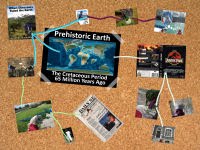


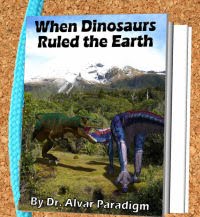


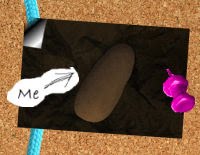





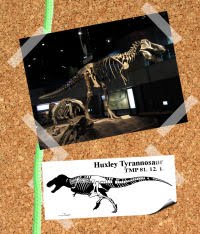








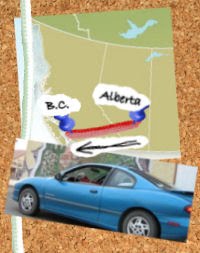






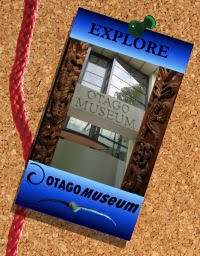

 so with that in mind welcome to virtual
so with that in mind welcome to virtual  with the completion of the rail line
with the completion of the rail line  with the death of the coal industry,
with the death of the coal industry,  of course it is these
of course it is these  however due to both
however due to both  scattered throughout town, since 2000 anyways, are dozens of "
scattered throughout town, since 2000 anyways, are dozens of " also many buildings have murals and paintings of various prehistoric scenes on them...
also many buildings have murals and paintings of various prehistoric scenes on them... in fact pretty much everywhere including plain old grocery stores, have something dinosaur related attached to them.
in fact pretty much everywhere including plain old grocery stores, have something dinosaur related attached to them. the pinnacle of the dinosaur theme though has to be the "world's largest dinosaur" located on the river front. right beside the only bridge crossing the red deer river in the valley, it is both hard to miss due to its size and its location.
the pinnacle of the dinosaur theme though has to be the "world's largest dinosaur" located on the river front. right beside the only bridge crossing the red deer river in the valley, it is both hard to miss due to its size and its location. of course the
of course the  the dinosaur attractions don't seem to stop popping up either it seems. since my departure from town 2 years ago, there is a new museum under construction. that's kinda weird.
the dinosaur attractions don't seem to stop popping up either it seems. since my departure from town 2 years ago, there is a new museum under construction. that's kinda weird.

